
Powerpoint Templates
Icon Bundle
Kpi Dashboard
Professional
Business Plans
Swot Analysis
Gantt Chart
Business Proposal
Marketing Plan
Project Management
Business Case
Business Model
Cyber Security
Business PPT
Digital Marketing
Digital Transformation
Human Resources
Product Management
Artificial Intelligence
Company Profile
Acknowledgement PPT
PPT Presentation
Reports Brochures
One Page Pitch
Interview PPT
All Categories


Operations Management Powerpoint Presentation Slides
Operations Management PowerPoint Presentation Slides allows the organization to measure the performance of its operations. Requirement engineering PowerPoint complete deck describe in detail about operation management process, operational goals, process timeline, competitive analysis value map, strategies for forward and backward integration, operation strategy, productivity table, forecasting table, system and design, product and service design, capacity planning for product, facility layout, location planning and analysis, quality management system, quality control timeline, supply chain management , inventory management and scheduling, inventory turnover KPIs, lean manufacturing to name a few. Explain goals of competitive criteria goals like cost, quality, speed, flexibility, reliability, etc with this visually stunning project production management PPT slides. Showcase the steps of capacity strategy planning. Design of work system, process, technology, people and infrastructure management can be well explained with this business process mapping PowerPoint templates. Furthermore, using this business operation presentation design, you can brief your audience about aggregate production planning, effective lean techniques, inventory scheduling, project management, roles and responsibilities matrix, work breakdown structure, etc.

- Add a user to your subscription for free
You must be logged in to download this presentation.
Do you want to remove this product from your favourites?
PowerPoint presentation slides
Presenting this set of slides with name - Operations Management Powerpoint Presentation Slides. All slides are completely editable and professionally designed by our team of expert PowerPoint designers. The presentation content covers all areas of Operations Management Powerpoint Presentation Slides and is extensively researched. This ready-to-use deck comprises visually stunning PowerPoint templates, icons, visual designs, data-driven charts and graphs and business diagrams. The deck consists of a total of seventynine slides. You can customize this presentation as per your branding needs. You can change the font size, font type, colors as per your requirement. Download the presentation, enter your content in the placeholders and present with confidence

People who downloaded this PowerPoint presentation also viewed the following :
- Business Slides , Flat Designs , Strategic Planning Analysis , Complete Decks , All Decks , Strategic Management , Operations and Logistics , Management , Proposals , Operations , HR Proposal , Management , Operations Management
- Business Operations ,
- Company Operations ,
- Supply Chain Inventory And Logistics ,
- Operations Management
Content of this Powerpoint Presentation
Slide 1 : This slide introduces Operations Management. State Your Company Name and begin. Slide 2 : This slide shows Outline of the presentation. Slide 3 : This slide presents Introduction describing- Forecasting Table, Productivity Table, Strategy, Competitive Analysis, Process Timeline, Operational Goals, Operations Management Process, Background. Slide 4 : This slide displays Background describing- Places of Operation, Major Lines of Product, Employees, Facility, Products/Services Investigated, Annual Sales. Slide 5 : This slide represents Operation Management 8 Step Process. You can add data as per requirements. Slide 6 : This slide showcases Operation Management 7 Step Process with icons and text boxes. Slide 7 : This slide shows Operation Management 6 Step Process. You can add or edit data as per requirements. Slide 8 : This slide presents Operation Management 5 Step Process. Slide 9 : This slide displays Operation Management Process describing- Monitoring & Control, Inputs, Transformation System, Outputs, Environment. Slide 10 : This slide represents Operations Goals with related imagery and text. Slide 11 : This is another slide for Operations Goals describing- Goals, measures, targets, frequency and year to date. Slide 12 : This slide showcases Process Timeline on yearly and quarterly basis. You can add or edit data as per needs. Slide 13 : This is another slide displaying Process Timeline on monthly basis. Slide 14 : This slide shows Competitive Analysis Value Map comparing quality and price. Slide 15 : This slide presents Competitive Strategies describing- Operational Excellence, Customer Intimacy, Product Leadership. Slide 16 : This slide displays Competitive Criteria For Service Operations. Slide 17 : This slide represents Strategies for Forward & Backward Integration describing- Raw Materials, Intermediate Goods, Manufacturing, Marketing Sales, After Sales Services. Slide 18 : This slide showcases Operation Strategy with- Top-down Perspective, Market Requirements Perspective, Bottom-up Perspective, Operations Resources Perspective. Slide 19 : This slide shows Productivity Table. You can change the data as per requirements. Slide 20 : This slide presents Forecasting with related diagram and additional text boxes to show information. Slide 21 : This slide displays Forecasting Table on monthly basis. Slide 22 : This slide represents System & Design describing- Product & Service Design, Strategic Capacity Planning for Products & Services, Process Selection & Facility Layout, Design of Work System, Location Planning & Analysis. Slide 23 : This slide showcases Product & Service Design describing- Concept Generation Concept Screening Evaluation & Improvement Prototyping & Final Design Preliminary Design Slide 24 : This is another slide for Product & Service Design describing- Assets, People, Culture and Policy. Slide 25 : This slide shows Capacity Planning for Product. Slide 26 : This slide presents Capacity Requirement Table. You can change the data as per needs. Slide 27 : This slide displays Capacity Strategy Planning in tabular form. Slide 28 : This slide represents Process Planning comparing standardization and volume. Slide 29 : This slide showcases Facility Layout describing- Milling, Assembly & Test, Drilling, Plating, Grinding. Slide 30 : This slide shows Design of Work System describing- Process, Technology, People, Infrastructure, Management. Slide 31 : This slide presents Location Planning & Analysis in tabular form with categories as- Location, Estate size, Motorway distance, Possibilities of material procurement and Qualification of Job Seekers. Slide 32 : This slide is titled as Quality describing Quality management and Quality control. Slide 33 : This slide displays Quality Management System for Improving describing- Verify & Process, Stock & Materials, Plan & Equipment, Records & Documentation, Human Resources, Environmental Resources, Analysis & Monitoring. Slide 34 : This slide represents Quality Management Timeline on monthly basis. Slide 35 : This slide showcases Quality Control Management Planning, Analyze, Evaluate, Improve. Slide 36 : This slide presents Quality Control KPI Dashboard showing data in forms of graph. Slide 37 : This slide shows Quality Management Dashboard with chart and bar graphs. Slide 38 : This slide displays Quality Control KPI Metrics describing- No. of defects per lot, No. of corrective actions, Cost of quality. Slide 39 : This slide represents Quality Cost Report in tabular form with categories as- Types of Cost, Quality Cost, Percentage of Sales. Slide 40 : This slide showcases Quality Cost Report Comparison on yearly basis. Slide 41 : This slide shows Quality Control Check Sheet. Slide 42 : This slide presents Supply Chain Management describing- Supply Chain Management Process, Supply Chain KPI Dashboard, Supply Chain Management Bifurcation, Supply Chain Management Goals, Components of Supply Chain, Supply Chain Management Advantages, Supply Chain KPI Metrics. Slide 43 : This slide displays Supply Chain Management Process describing- Raw Materials, Supplier, Manufacturing, Retail, Consumer. Slide 44 : This is another slide displaying Supply Chain Management Process. Slide 45 : This slide represents Supply Chain Management Goals with related icons and text. Slide 46 : This slide showcases Supply Chain Management Bifurcation describing- Supply Chain Strategy, Supply Chain Planning, Supply Chain Enterprise Applications, Asset Management, Logistics, Product Life Cycle Management, Procurement. Slide 47 : This slide shows Components of the Supply Chain describing- Supply, Manufacturing, Retail, Consumer, Distribution & Warehousing. Slide 48 : This slide presents Supply Chain Management Advantages. Slide 49 : This slide displays Supply chain KPI Dashboard with the help of graphs. Slide 50 : This is another slide displaying Supply Chain Management KPI Dashboard. Slide 51 : This slide represents Supply Chain KPI describing- Percentage of Problem With Supplier, Number of Active Suppliers Per Supply Employee, Requested Time In Full. Slide 52 : This slide displays Inventory Management & Scheduling describing- Inventory Management System, Scheduling, Inventory Tracker Table, Inventory & Logistics Management, Aggregate Planning, Lean Manufacturing. Slide 53 : This slide represents Inventory Management Systems describing- Picking & Packing, Reporting Management, Receiving & Put Away, WI – FI & Barcode System, Location Management, Inventory Management. Slide 54 : This slide showcases Inventory and logistics dashboard describing- One Time Shipping, Avg Delivery Time in Days, Warehousing Operating Costs distribution, Transportation Related Costs, Shipments by Country. Slide 55 : This slide shows Inventory Planning KPI Dashboard. Slide 56 : This slide presents Inventory Delivery on Time Dashboards. Slide 57 : This slide displays Inventory Turnover KPI Metrics. Slide 58 : This slide represents Logistics KPI Metrics describing- Shipment by Country, Perfect order rate, Delivery Status. Slide 59 : This is another slide representing Logistics KPI Metrics. Slide 60 : This slide showcases Inventory Tracker Table. You can add or edit data as per requirement. Slide 61 : This slide shows Aggregate Production Planning in tabular form. Slide 62 : This slide presents Lean Manufacturing describing- People, Total Quality focus, Continuous Improvement, Systems, Technology, Short Cycles. Slide 63 : This slide displays Benefits of Effective Lean Techniques and Management. Slide 64 : This slide represents Inventory Scheduling with help of tables and graph. Slide 65 : This slide showcases Project Management describing- Project Controls, RASCI Matrix, Work Down Structure, Project Management KPI Dashboard, Metrics, Roles & Responsibilities Matrix, Project Team. Slide 66 : This slide shows Project Team in hierarchy form. Slide 67 : This is another slide presenting Project Team. Slide 68 : This slide presents Project Team Matrix with designation. Slide 69 : This slide displays Roles & Responsibilities Matrix. Slide 70 : This slide represents RASCI Matrix describing person Responsible, Accountable, Consulted, Informed, Supportive. Slide 71 : This slide showcases Work breakdown Structure in form of tree diagram. Slide 72 : This is another slide showing Work breakdown Structure. Slide 73 : This slide shows Project Management Priority Dashboard with the help of tables and graphs. Slide 74 : This slide presents Project Management Monthly Growth Dashboard. Slide 75 : This slide displays Project Status KPI Metrics with sales on monthly basis. Slide 76 : This slide represents Project Status KPI Metrics with project expenditure. Slide 77 : This slide showcases Project Controlling Process with related diagram. Slide 78 : This slide shows Project Controls Tools describing- Planner/ Scheduler Tools, Cost Controller Tools, Cost/Schedule Risk Analyst Tools, Cost Estimator Tools. Slide 79 : This is a Thank You slide with address, contact numbers and email address.
Operations Management Powerpoint Presentation Slides with all 79 slides:
Use our Operations Management Powerpoint Presentation Slides to effectively help you save your valuable time. They are readymade to fit into any presentation structure.

Operations Management refers to the process of overseeing, designing, and controlling the various operations and processes within an organization, with the goal of achieving optimal efficiency, productivity, and profitability.
Some of the key components of Operations Management include forecasting, productivity, strategy, competitive analysis, process timeline, operational goals, and the Operations Management Process.
The Operations Management Process is a series of steps or stages that organizations follow to manage their operations effectively. These steps typically include planning, organizing, staffing, controlling, and evaluating various aspects of the organization's operations.
Quality Management refers to the process of ensuring that products and services consistently meet or exceed customer expectations, while also reducing defects, errors, and waste in the production process.
Supply Chain Management refers to the process of managing the flow of goods, services, and information from suppliers to customers, with the goal of maximizing efficiency and minimizing costs. This process typically involves a range of activities such as sourcing, procurement, production, and distribution.
Ratings and Reviews
Items 1 to 10 of 11 total
- You're currently reading page 1

by omar walid
May 8, 2023
by SHAIMAA ELFEQI
by test testing
March 19, 2023
by randa qadomi
September 19, 2022
by Mohamed Amine
January 18, 2022
by Walsh Turner
December 27, 2021
by Demarcus Robertson
by O'Sullivan Evans
by O'Ryan Edwards
by O'Neill Reyes

Operations Plan Presentation Template
Need to keep your team on track towards a goal or objective? Use an operations plan to outline your business strategy. An operations plan presentation keeps all of your team members on the same page, ensuring that they understand their roles, responsibilities, and how they fit into the overall project. An operations plan is an essential component to your project’s success.
Use an operations plan to:
- Outline a project’s objectives, strategy, and goals
- Reflect on the project roll-out by team
- Show managers and executives how the project is progressing
Customize your Operations Plan Presentation
Every slide in your operations plan plays an important role in your business strategy. To drive your point home with each slide, you might add Venn diagrams, graphs, charts, sales funnels, and other graphics. You might include slides such as:

Pro Tips for an Operations Plan
When creating an operations plan presentation, there are a few things to keep in mind to make it as concise and impactful as possible.
Bar graphs, timelines, bullet lists, tables: graphics can make your information memorable and easy to digest.
Limit each slide to one idea or topic. When your slides are overcrowded, you’ll overwhelm the viewer.
Your team members will naturally have questions after you bring up certain topics. Leave some room in your presentation for discussion or Q&A.
An operations plan regroups your team so you can all reach a business objective. Be sure to include summaries and next steps for everyone on the project so that no one is left wondering about their role.
More Popular Templates

Go to Market Strategy Example
Plan out your next product or service launch, brand relaunch, or startup launch with a go to market strategy presentation.

QA Testing Presentation Template
Learn how Beautiful.ai’s QA testing template can help product teams plan for and test new releases before a launch.

Mixpanel Pitch Deck
Mixpanel is a business analytics company that helps measure user engagement and retention. We took a look at Mixpanel’s original pitch deck to look for ways to improve the design.

Social Media Report Template
Use a social media report template to present social media findings to your team, upper management, or new clients.
.jpeg)
Quora Pitch Deck Template
The Quora website helps users find answers to questions so we’ve updated their presentation deck to help answer “How to structure a presentation.”

Project Retrospective Presentation Template
Learn how Beautiful.ai’s project retrospective template can help your team reflect on a completed project and learn from the successes and failures.

Operations Management
What do you think of this template.

Product details
Operations management involves utilizing resources from staff, materials, equipment, and technology. Operations managers acquire, develop, and deliver goods to clients based on client needs and the abilities of the company.
Operations management handles various strategic issues, including determining the size of manufacturing plants and project management methods and implementing the structure of information technology networks. Other operational issues include the management of inventory levels, including work-in-process levels and raw materials acquisition, quality control, materials handling, and maintenance policies.
Operations management entails studying the use of raw materials and ensuring minimal waste occurs. Operations managers utilize numerous formulas, such as the economic order quantity formula to determine when and how large of an inventory order to process and how much inventory to hold on hand.
A critical function of operations management relates to the management of inventory through the supply chain. To be an effective operations management professional, one must be able to understand the processes that are essential to what a company does and get them to flow and work together seamlessly. The coordination involved in setting up business processes in an efficient way requires a solid understanding of logistics.
An operations management professional understands local and global trends, customer demand, and the available resources for production. Operations management approaches the acquisition of materials and the use of labor in a timely, cost-effective manner to deliver customer expectations. Inventory levels are monitored to ensure excessive quantities are on hand. Operations management is responsible for finding vendors that supply the appropriate goods at reasonable prices and have the ability to deliver the product when needed.
Another large facet of operations management involves the delivery of goods to customers. This includes ensuring products are delivered within the agreed time commitment. Operations management also typically follows up with customers to ensure the products meet quality and functionality needs. Finally, operations management takes the feedback received and distributes the relevant information to each department to use in process improvement.
Operations management is concerned with controlling the production process and business operations in the most efficient manner possible. Operations management professionals attempt to balance operating costs with revenue to maximize net operating profit.
This template will be useful for company leaders when preparing a company development strategy. Production managers can use this template when planning product releases. Project managers can detail timelines and milestones for new projects.
Logistics managers can use this template when preparing information about the supply chain of raw materials using sea and rail transport. Startup executives can use this template when preparing for a meeting with investors. Financiers and economists can use this template when preparing analytical reports on the efficient use of company resources.
Operations Management is a professional and modern template that contains six stylish and fully editable slides. If necessary, you can change all elements of the slide in accordance with your corporate requirements. This template will be useful for project managers, company leaders, startups. The Operations Management template will seamlessly complement your presentations and will be a great addition to your collection of professional presentations.
Related Products

Creative Jigsaw Puzzle Pieces
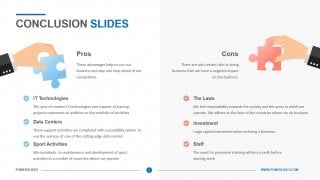
Conclusion Slides

Economic Value Added

Survey Results

Bell Curve Graph
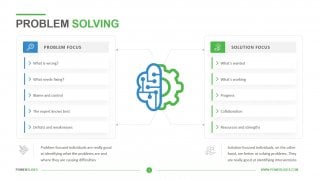
Problem Solving
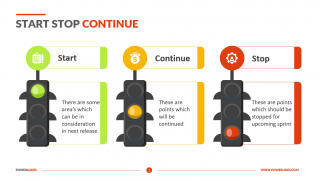
Start Stop Continue
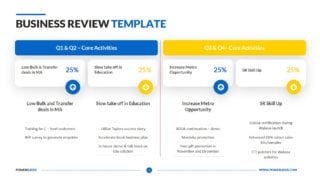
Business Review
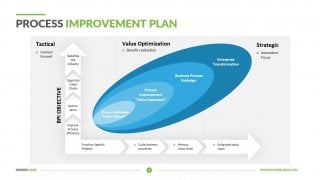
Process Improvement Plan

What If Analysis
You dont have access, please change your membership plan., great you're all signed up..., verify your account.
PowerSlides.com will email you template files that you've chosen to dowload.
Please make sure you've provided a valid email address! Sometimes, our emails can end up in your Promotions/Spam folder.
Simply, verify your account by clicking on the link in your email.
Operations Management 101 & 201: Definitions, Pro Tips, Trends
By Kate Eby | May 25, 2017 (updated March 3, 2023)
- Share on Facebook
- Share on LinkedIn
Link copied
The term operations management encompasses planning, implementing, and supervising the production of goods or services. Operations managers have responsibilities in both strategy and day-to-day production, in either manufacturing or services. Sometimes called production management, the field is cross-functional, tying in with other departments such as sales, marketing, and finance. It’s involved in product or service creation, development, production, and distribution. In effect, it connects dots along the value chain.
Technology, ever changing, plays a key role in springboarding constant advancements in operations management (OM). That’s truer now than ever before thanks to budding advancements like self-maintaining smart machines (for production) and drones (for distribution). Companies that use technology well can thrive, and those that don’t may not survive.
“The future of operations management is going to involve increasing automation to the point that we will hardly recognize the way new organizations function,’’ says Iris Tsidon, Co-Founder and CEO of Okapi Vision , a cloud-based key performance indicator (KPI) platform.
This article will provide an overview of operations management: its history, importance, functions, strategies, principles, and types of production. You’ll also hear from seven operations management professionals about tips, challenges, trends, and the future.

Deeper Definitions: What Does Operations Management Mean?
Operations management refers to the activities involved in overseeing the process of creating goods and providing services, including resources, technology, people, and products. These elements must be well managed in order for the business to remain competitive.
As we define operations management more fully, we consider these foundations of OM:
- Planning: Operations managers must constantly forecast, plan, and adjust to optimize processes based on conditions.
- Process: Production of goods or services requires having strong, repeatable processes.
- Efficiency: Managers must troubleshoot bottlenecks, inadequate resources, and downtimes to create optimal efficiency.
- Cost Control: Production is typically a major part of a company’s cost structure, and you must manage it wisely.
- Quality: Good quality control is necessary to maintain customer satisfaction and the company’s reputation. Companies can greatly suffer without it.
- Continuous Improvement: To remain competitive, companies need to have processes in place to consistently seek better ways of doing things.
- Technology: Underlying all of these foundations is technology. Well-used technology keeps a company ahead of the curve.
- Profitability: Executed properly, all of the above foundations lead to a strong bottom line.
Project Management Guide
Your one-stop shop for everything project management

Ready to get more out of your project management efforts? Visit our comprehensive project management guide for tips, best practices, and free resources to manage your work more effectively.
View the guide
The History of Operations Management
Operations management dates back to 5000 B.C. with the Sumerians, who tracked inventories, transactions, and taxes, and has evolved into modern day services like overnight and same-day deliveries. We’ve listed some notable historical highlights below:
- The Industrial Revolution (1760s to early 1800s) ushered in the foundations of division of labor and interchangeable parts, keys to efficient production. Eli Whitney, inventor of the cotton gin, also manufactured 10,000 muskets by using the concept of interchangeable parts.
- In 1883, Frederick Winslow Taylor used the stopwatch method to time tasks for complex jobs. This became key for studying efficiency and productivity.
- In about 1912, Frank and Lillian Gilbreth laid the foundation for predetermined motion time systems (PMTS), which predict the time it takes to complete tasks.
- In 1913, Henry Ford’s first moving assembly line started rolling, cutting production time for a car from 12 hours to less than three.
- In post-World War II Japan, Toyota developed just-in-time production (JIT), later called the Toyota Production System. The company designed it to eliminate waste and increase productivity and quality.
- In 1971, FedEx started overnight package deliveries. Nowadays, Amazon even offers same-day delivery on orders.
The Importance of Operations Management
Operations management serves as an organization’s engine room , and plans and drives manufacturing and services. Operations managers maximize efficiency, productivity, and profit, which are vital to a company’s growth, survival, and competitive edge.
Most companies have an operations department with many employees and a large budget. Forbes magazine reported in 2011 that three-quarters of CEOs come from an operations background, which shows the importance of understanding how a company functions.
We can also see the importance of operations management in these aspects of a company’s success:
- Customer service
- Product or service quality
- Correctly-functioning processes
- Market competitiveness
- Technological advances
- Profitability
It’s no exaggeration to say everything depends on operations.
Functions and Roles in Operations Management
Operations management includes a diverse set of functions and roles, which can differ based on industry and company size. To carry out these tasks well, operations managers need to be organized, analytical, creative, resourceful, versatile, and have strong leadership skills.
Now more than ever, operations managers need to be tech-savvy to compete in a rapidly changing market. Technical specialization can arm you with the analytical and problem-solving skills vital to succeeding in this field. We’ve listed the major functions and roles required of a modern operations manager below:
- Planning and implementing manufacturing plants
- Managing projects
- Planning information systems
- Helping to design and develop products and services
- Managing inventory through the supply chain
- Managing delivery to customers in a timely manner
- Optimizing quality control
- Conducting procurement and purchasing
- Managing logistics
- Managing transportation and distribution
- Managing and maintaining facilities
- Conducting enterprise resource planning (ERP)
- Forecasting for planning
- Capacity planning
- Navigating industrial labor relations
- Analyzing the value chain
- Optimizing resource allocation
- Eliminating waste and bottlenecks
- Continuously improving processes
- Executing a company’s strategic plan
The Relationship of Operations Management to Other Departments
Operations managers facilitate cooperation between departments and ensure that department and company goals are aligned, and to standardize logistical approaches to budget and project constraints. Operations teams must collaborate with all other departments to be effective.
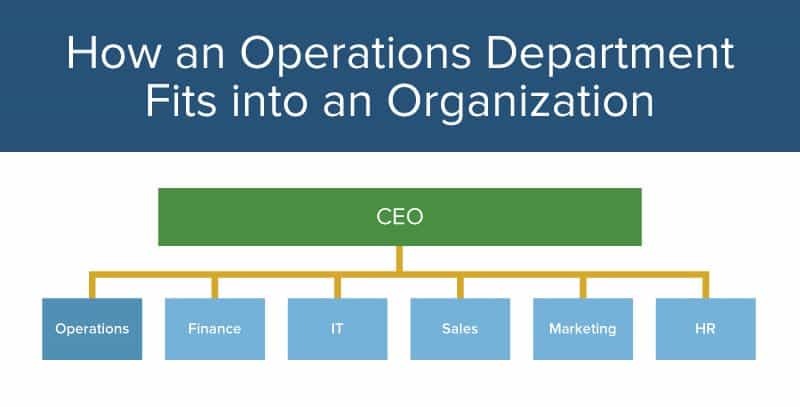
Operations Management Strategies
Operations managers are deeply involved in strategy, in addition to their daily production roles. From designing and testing processes to facilitating interdepartmental collaboration, we have outlined some key strategy and tactics points below:
- Data Use: Analytics are essential for strong planning, adjustments, and decision making. Two common types are efficiency metrics and effectiveness metrics.
- Inventory Analysis: To manage inventory in the supply chain, ABC analysis (also called Pareto analysis ) comes into play. This method divides inventory into three categories: A, B , and C . Category A has the highest value and tightest controls, and Category C has the lowest value and loosest controls.
- Data Challenges: Data is often siloed, which makes it difficult to compare. But newer systems and setups make this process easier and help analysts and managers to examine data in new, helpful ways.
- Process Design: Researching, forecasting, and developing a sound process takes expertise and energy, but the results can be lasting.
- Forecasting and Goal Setting: The best forecasting often combines a look at historical data with an analysis of changing conditions.
- Collaboration Among Departments: With good communication and collaboration, operations management can work effectively with finance, sales, marketing, human resources, and other departments.
- Being Green: Ecological soundness has become a strategic and legal necessity at companies nowadays, especially in manufacturing.
- Managing People: With all the advancements in machinery and technology, people remain critical to the equation, though often in different types of jobs.
Levels of Operations Management
Operations management includes three levels: strategic, tactical, and operational. The strategic level defines company goals, and the tactical level outlines a plan to implement that strategy. The operations level contains the daily operations required to produce the desired outcome.
Principles of Operations Management
There are many widely accepted principles of operations management. Most experts advise a focus on organization, risk management, and adaptation. We’ve outlined two prominent lists of principles by experts below:
Randall Schaefer, CPIM, described The 10 Principles of Operations Management at his presentation at the 2007 conference of the American Production and Inventory Control Society ( APICS ).
- Reality: There is no universal solution to the problems in your business.
- Organization: You must organize all aspects of production into a coherent whole.
- Fundamentals: Adhere to fundamentals, such as accurate inventory records.
- Accountability: People try harder when they’re held accountable.
- Variance: Variance is part of every process.
- Causality: Problems are often symptoms. Get to the root cause.
- Managed Passion: People with a passion for their jobs will drive your company.
- Humility: You don’t have to know everything.
- Success: Define success, and change with the market.
- Change: Every manufacturing solution is temporary.
Another set of operations management principles comes from author Dr. Richard Schonberger . His 16 principles are:
- Team up with customers. Know what they buy and use.
- Engage in continual, rapid improvement.
- Maintain a unified purpose. Involve employees in strategy.
- Know the competition.
- Organize resources.
- Invest in HR.
- Maintain equipment.
- Use the simplest, best equipment.
- Minimize human error.
- Cut times. Shorten the product path to the customer.
- Pull the system. Improve the workflow and cut the waste by producing on demand.
- Employ total quality control.
- Fix root causes.
- Manage visibility. Let the market know about your achievements.
Types of Production and Production Systems
You can categorize production and production systems in several ways, including by technical elements, processes, or lead time. Most modern production systems are software-based, meaning that planning, scheduling, and inventory control systems and processes are managed by software.
- Technical Elements: This includes machines, tools, and organizational behavior, such as people, division of labor, and information flow.
- Process Production versus Parts Production: Process production means the product undergoes a physical-chemical transformation, such as paper or cement. Parts production means parts are made and assembled into a product.
- Lead time: Categories include purchase to order, make to order, assemble to order, and make to stock.
The Biggest Operations Management Challenges
Some of the biggest operations management challenges include acquiring and maintaining the right workforce and the right technology. We’ve asked our experts to weigh in on some other common challenges below:

Iris Tsidon: The CEO of Okapi Vision notes that, “Today's biggest challenges in operations are all related to keeping up with the pace of innovation. Millennials are the largest population entering the workforce. They expect that the companies they work for are going to be as tech savvy as they are, yet existing employees resist change and implementing new technologies. So there is a clash between generations, and operations management needs to balance between the two.”

Daisy Jing : CEO and founder of Banish beauty product line says the biggest challenges are “making sure that we get the right people and maintain their good performance for years to come.”

Katharine Leonard: Lean Six Sigma Black Belt and Co-Founder of ShiftChange says, “It's when you don’t have the right resources and the time or leadership support to solve business problems and instead [put] a Band-Aid on problems. Because of this, teams end up overcomplicating their processes and relying on a few experts, who become the single point of failure for your business.”

Matt Wilhelmi: Associate Business Consultant for Individual Advantages Business Advisors advises, “Managing the operations of small and medium-sized businesses comes down to effective communication. There are so many distractions in today’s workplace that we sometimes lose sight of how we communicate. In our experience, effective communication means being consistent and fair. The challenge in effective communication is that sometimes an operations manager needs to encourage and other times needs to discipline/coach. This all happens while maintaining the vision he or she casts for the team.”

Chris Wiegand: CEO of the Jibestream “indoor navigation” platform , comments, The ‘Internet of Things’ — the interconnection of computerized devices via the Internet — has the potential to drive efficiency, but it also brings challenges in complexity and cost. To be efficient, companies need a location infrastructure using addressable maps and technologies, like Bluetooth beacons. An example is a hospital knowing the real-time location of its infusion pumps and other devices to organize their usage. A big challenge is that companies often store data in separate databases, leaving analysts to pull it into spreadsheets to compare. "There’s no single dashboard to bring it into.”

Richard Lowe, Jr.: The former Director of Computer Operations for Trader Joe’s and current Owner and Senior Writer of The Writing King says, “The technology is changing so quickly, it makes it hard on an operations manager to keep up...The whole model of the way things are working is changing." Using the example of trucking for product distribution, concepts such as robotic trucks and location-aware tracking bring challenges along with advancement. "It’s a lot more data to manage." Technology training presents challenges too. "How do you keep people up to speed with new technologies?”
David Shelton: COO of healthcare service company PatientMatters lists these challenges: “Staffing: I'm convinced your staffing determines your success. A mixture of new employees combined with seasoned experts allows your operation to maintain stability while training staff, expanding sales opportunities, and identifying new solutions to existing problems. Technology: Whether a service provider or manufacturer, new technology and your ability to understand and react to internal data will dictate your operational success. Growth: Do you have the materials, vendor relationships, and labor to keep pace with your sales team and market demands?"
Tips for Good Operations Management
Operations management is concerned with the quality of a company’s technology and people. Our experts provide their best tips for how to maintain quality resources to ensure efficient and effective operations management:
- Keep Current on Innovation Trends: “Take the time to listen to suggestions of tech-savvy employees; only use technology that is simple to use and engaging for employees at every skill level,” suggests Tsidon. “Invest in educating managers and employees on the goals of implementing new systems, and make sure to build in rewards so that everyone is motivated to learn and use new technology.”
- Encourage Effective Communication: “Make sure that you communicate processes, rules, and policies to everyone. Have a smart marketing plan and be up to date. Pattern your marketing plan after whatever is on trend. Do it as soon as possible, and use that concrete plan with a timeline until a new trend arrives. Have weekly reports of everything about the company. Then, from there, manage everything based on the needs of each category,” says Jing.
- Collect Data Electronically: “Having team members write down their processing numbers for data collection can lead to inaccurate data and [will] not give you the results you need to run your operations efficiently,” explains Leonard. “Use report dashboards and rely on data and analytics. Determine what information you need to run your business, measure it, and use analysis to augment your process and continually improve your operations. Be customer-focused: Design your processes with the end customer in mind. Think about what they see as value and what they’re willing to pay for, as well as how quickly they expect to get results.”
- Listen to Your Teams: “Field-level employees, internal sales, and vendors have invaluable information and know what is going on with your product or services and the competition,” notes Shelton. “Measure and analyze. We are constantly examining our internal processing times and employee performance and measuring success rates. Measuring your internal performance allows you to exceed customer demand. Expand your network. Managers from competitive firms change jobs. A friendly relationship can become a key alliance. Vendor partnerships in developing new products or services allow you to grow your operations while controlling costs. Joint ventures that benefit both parties can substantially increase your knowledge base while increasing your speed to market.”
- Slow Down: “It’s important to consider the side effects of each decision and how you relay communication to the team,” advises Wilhelmi. “People tend to like working for (and have higher engagement with) leaders who maintain a level head and aren’t too quick to pass judgment. Be proactive and strategic. It’s important that leaders aren’t reacting all day. The constant reactionary environment can turn great leaders into fire chasers, which tends to devolve their communication. Stay focused on the numbers. If something isn’t working as it should, it’s better to focus on the measurable data than on the emotion of disappointment or the result. When you can tweak a process and measure it along the way, you remove the subjectivity and remain objective.”
- Assign an Internal Owner: Make sure every project has an internal owner, or it can go off track,” says Wiegand. “Understand the key performance indicators that will drive the business. Just because you can measure it doesn’t mean it matters. Protect the data. Operations managers have to safeguard the info. Consider leveraging infrastructure as a service, with hosting, security, and redundancy built-in.”
- Keep Up With Your Field: “Read a lot. Learn a lot. If you’re a logistics manager, connect with your tech people,” suggests Lowe, Jr.
Current Trends in Operations Management
The field of operations management has evolved over time to keep pace with technology and human behavior. From Lean manufacturing to sustainability, we’ve outlined some current and existing trends for operations managers:
- Business Process Reengineering (BPR): BPR helps companies revamp their organizations from the ground up by reorganizing and reassigning processes to better align with company goals.
- Lean Manufacturing: Lean, Six Sigma, and Agile are disciplines focused on efficient, adaptable production. They continue to be mainstay approaches.
- Reconfigurable Manufacturing Systems: These systems are designed to be flexible and adaptable to sudden market changes.
- Behavioral Operations Management: This approach focuses on human behavior as it relates to operations management.
- Sustainability: This approach highlights maintaining ecologically-minded practices under changing laws.
Expert Opinions on Operations Management Trends
Most experts agree that computers and tech are at the center of operations management. We’ve gathered expert observations of current operations management trends, from data visualization and forecasting to further trends, below:
- Data Visualization: “The key trend that I see is companies combining data visualization with key performance indicators to create real-time monitoring and management systems,” says Tsidon.
- Automation: “I see firms moving toward technology to solve the mundane, time- consuming, and error-prone tasks that inhibit operations teams from providing the best service to customers,” Leonard notes.
- Trend Forecasting: “How can you incorporate internal and external data to make decisions that are ahead of the curve?” asks Shelton. “The best sports analogy I know is ‘Skate where the puck is going.’ We've got to be planning ahead in order to anticipate customer needs and beat our competitors; managing resources and minimizing waste. Both product and service organizations wrestle with maximizing resources (materials or staff) to produce the best product for the consumer.”
- Collaboration: “I see operations management becoming more closely aligned with human resources as companies are increasingly aware of how important their culture and human capital are as they relate to operations and engagement,” observes Wilhelmi.
- Location Technology: “With hyper-accurate location services, one trend is using that technology for real-time alerts, such as for a dementia patient wandering off,” says Wiegand.
- Use of the Internet: “Internet shopping continues to be a big trend, involving pretty much any product, including food. Amazon sends some products within a few hours of being ordered. You better be able to match that. You have to be able to meet tighter inventories, such as just-in-time (JIT) stocking, with some food staples, such as bread and eggs, arriving two or three times per day,” notes Lowe, Jr.
What Is the Future for Operations Management?
The future of operations management can be inferred from its past. While no one can know for sure, our experts anticipate a future of ever-increasing data and technology, including self-drive vehicles and the automation of low-skilled jobs.
- Automation: “With increasing automation will come sweeping organizational change,” Tsidon says. “Operations are going to reduce hierarchy and make management easier, so, while many are concerned about the loss of low-level jobs, I see that there will be a sweeping change at every level, including upper management. Previous positions that needed highly skilled workers will no longer exist because artificial intelligence will provide better results without human error. In the future, the most valuable management skills will be the ability to combine data analysis with emotional intelligence. This is something that no algorithm can replace and that will be more crucial than ever.”
- Remote Management: “The future will bring remotely-handled operations management. Nowadays, there's nothing a remote worker cannot do. It is possible, and it will be the next trend,” predicts Jing.
- May Require a Technical Background: “I envision operations management becoming a high-tech position, requiring a highly analytical skill set and product-focused mindset,” says Leonard. “With Amazon delivering packages on the same day, customers are coming to expect instantaneous results, and, to maintain competitiveness, operations needs to drive toward that type of success.”
- Larger Focus on Quality Labor: “There are opportunities presented by technology to build or service faster, better, and cheaper. It’s critical to utilize technology, interpret data, source new materials, and identify talented labor. You must confront labor challenges and build a better workforce. How do you better utilize your labor force? Improved recruiting techniques allow you to draw in new labor, but how can you also better train existing staff to advance within the organization? This is a key area we are focusing on. We strongly believe we have an obligation to train our existing team to grow and advance internally,” explains Shelton.
- Human Resources: “The future of operations management is sliding toward creating data (so it can be measured and studied from an objective position) around the culture of a company’s human operations. Dozens of reports have come out in the past few years that are confirming that lack of engagement by employees leads to a substantial loss of productivity — or worse, high turnover. In the truest sense, it’s the operations manager’s responsibility to maximize their operations. The better your culture, the better your operations,” observes Wilhelmi.
- Location Based Services: “The future will include location-aware devices and smart buildings that will maintain themselves,” predicts Wiegand. “For example, an elevator could know that it needs service work through data inputs and could initiate the repair as part of a structured workflow. There will be greater use of artificial intelligence to recognize a problem and start a workflow. There will also be greater use of predictive analytics. Moreover, you’ll see greater protection of proprietary data, especially if problems result from data being too available. Finally, you’ll find greater gender equality in operations management. We certainly have great female leaders in operations today. That diversity brings a lot of value.”
Other Resources for Operations Management
- American Production and Inventory Control Society (APICS)
- Journal of Operations Management
- Professor Gad Allon's online course , Northwestern University
- Wharton online course
- University of Illinois online course
- Introducing Operations Management
Effectively Manage Operations with Smartsheet
Empower your people to go above and beyond with a flexible platform designed to match the needs of your team — and adapt as those needs change.
The Smartsheet platform makes it easy to plan, capture, manage, and report on work from anywhere, helping your team be more effective and get more done. Report on key metrics and get real-time visibility into work as it happens with roll-up reports, dashboards, and automated workflows built to keep your team connected and informed.
When teams have clarity into the work getting done, there’s no telling how much more they can accomplish in the same amount of time. Try Smartsheet for free, today.
Discover why over 90% of Fortune 100 companies trust Smartsheet to get work done.
Got any suggestions?
We want to hear from you! Send us a message and help improve Slidesgo
Top searches
Trending searches

11 templates

67 templates

21 templates

environmental science
36 templates

9 templates

holy spirit
Operations research, it seems that you like this template, operations research presentation, free google slides theme, powerpoint template, and canva presentation template.
Download the "Operations Research" presentation for PowerPoint or Google Slides. The world of business encompasses a lot of things! From reports to customer profiles, from brainstorming sessions to sales—there's always something to do or something to analyze. This customizable design, available for Google Slides and PowerPoint, is what you were looking for all this time. Use the slides to give your presentation a more professional approach and have everything under control.
Features of this template
- 100% editable and easy to modify
- Different slides to impress your audience
- Contains easy-to-edit graphics such as graphs, maps, tables, timelines and mockups
- Includes 500+ icons and Flaticon’s extension for customizing your slides
- Designed to be used in Google Slides, Canva, and Microsoft PowerPoint
- Includes information about fonts, colors, and credits of the resources used
How can I use the template?
Am I free to use the templates?
How to attribute?
Attribution required If you are a free user, you must attribute Slidesgo by keeping the slide where the credits appear. How to attribute?
Related posts on our blog.

How to Add, Duplicate, Move, Delete or Hide Slides in Google Slides

How to Change Layouts in PowerPoint

How to Change the Slide Size in Google Slides
Related presentations.

Premium template
Unlock this template and gain unlimited access

Register for free and start editing online
NRC Group ASA - Invitation to Capital Markets Update and first quarter 2024 presentation
NRC Group ASA is pleased to invite investors, analysts, media and other stakeholders to its Capital Markets Update and first quarter 2024 presentation on Thursday 23 May.
The company will provide information on NRC Group's new strategy, operations, markets, financial development and outlook. The Capital Markets Day presentation material and the first quarter 2024 results will be published the same day at 07.00 AM (CEST).
The event will be held in Ruseløkkveien 26 (ABG Sundal Collier), Oslo, and will start at 09.00 AM (CEST) and is expected to last approximately two hours, including Q&A. The presentations will be given in Swedish/English.
Topics that will be covered:
• First quarter 2024 results
• Lauch of new company strategy
• Priority Markets
• Financial targets
• Performance and market opportunities
• Structural and operational improvement areas
Speakers at the event:
• Anders Gustafsson – CEO
• Ole Anton Gulsvik – CFO
• Lene Engebretsen – EVP & Head of Communications
• Harri Lukkarinen – EVP and Managing Director NRC Group Finland
The presentation will also be broadcasted as a webcast on the following link:
https://channel.royalcast.com/webcast/hegnarmedia/20240523_4
The financial report and presentation will be made available under the company's ticker "NRC" on www.newsweb.no and on the company's homepage: www.nrcgroup.com
This information is subject to the disclosure requirements pursuant to section 5 -12 of the Norwegian Securities Trading Act.
https://news.cision.com/nrc-group/r/nrc-group-asa---invitation-to-capital-markets-update-and-first-quarter-2024-presentation%2Cc3982956

IMAGES
VIDEO
COMMENTS
The presentation content covers all areas of Operations Management Powerpoint Presentation Slides and is extensively researched. This ready-to-use deck comprises visually stunning PowerPoint templates, icons, visual designs, data-driven charts and graphs and business diagrams. The deck consists of a total of seventynine slides.
Use an operations plan to outline your business strategy. An operations plan presentation keeps all of your team members on the same page, ensuring that they understand their roles, responsibilities, and how they fit into the overall project. An operations plan is an essential component to your project's success. Use an operations plan to:
Operations Management is a professional and modern template that contains six stylish and fully editable slides. If necessary, you can change all elements of the slide in accordance with your corporate requirements. This template will be useful for project managers, company leaders, startups. The Operations Management template will seamlessly ...
This is a flexible boundaries of operation management ppt powerpoint. This is a seven stage process. The stages in this process are operations management, marketing, product or service development, accounting and finance, people management, technical functions, supply chain management. Slide 1 of 7.
A general corporate presentation should give an all-encompassing overview of the company, its operations and notable accomplishments. Corporate Slideshow Presentation Template. This template is perfect for any general corporate presentation. It features a clean and modern design, making it visually appealing.
This is a business operations ppt powerpoint presentation complete deck with slides. This is a one stage process. The stages in this process are marketing, business, management, planning, strategy. Slide 1 of 80. Deploying XP Practices To Enhance Operational Efficiency Ppt PowerPoint Presentation Complete Deck With Slides.
Here we are to help you with business operations strategy model PowerPoint presentation slides. This operational management presentation would be helpful in presenting and reviewing the business operations of the company. Our change management model PPT templates contains various slides on firm operations summary, milestones achieved, company ...
This is a business operations ppt powerpoint presentation complete deck with slides. This is a one stage process. The stages in this process are marketing, business, management, planning, strategy. Slide 1 of 81. Optimize Enterprise Core Business Operations Ppt PowerPoint Presentation Complete Deck With Slides.
9. Risk Analysis Presentation Template. Business operations management involves identifying, assessing and mitigating risks that can impact an organization's ability to achieve its objectives. Effective risk analysis is essential in this process and this presentation template can help you convey your risk analysis findings.
This PPT deck displays eighty slides with in depth research. Our topic oriented Company Operations PowerPoint Presentation Slides presentation deck is a helpful tool to plan, prepare, document and analyse the topic with a clear approach. We provide a ready to use deck with all sorts of relevant topics subtopics templates, charts and graphs ...
The term operations management encompasses planning, implementing, and supervising the production of goods or services. Operations managers have responsibilities in both strategy and day-to-day production, in either manufacturing or services. Sometimes called production management, the field is cross-functional, tying in with other departments ...
Color. Skip to start of list. 7,451 templates. Create a blank Business Presentation. Blue Dark Professional Geometric Business Project Presentation. Presentation by Olmos Carlos. Colorful Modern Business Infographic Presentation. Presentation by Bekeen.co. Creative and Minimal Portfolio Presentation.
This presentation is made up of multiple slides that will help you in so many ways. You can present and review the performance of your organization's employees. With various slides on firm operations, milestones achieved, company objectives, key performance indicators, you can ensure smooth management operations.
The following are some suggestions that businesses can use to improve business operations: 1. Measure performance. A business should come up with realistic and actionable means of measuring its business milestones. The process of measuring performance starts from the goal-setting stage.
Download the Essential Oil Business Plan presentation for PowerPoint or Google Slides. Conveying your business plan accurately and effectively is the cornerstone of any successful venture. This template allows you to pinpoint essential elements of your operation while your audience will appreciate the clear and concise presentation, eliminating ...
Download the "Operations Research" presentation for PowerPoint or Google Slides. The world of business encompasses a lot of things! From reports to customer profiles, from brainstorming sessions to sales—there's always something to do or something to analyze. This customizable design, available for Google Slides and PowerPoint, is what you ...
5,420 templates. Create a blank Company Presentation. Minimalist Beige Cream Brand Proposal Presentation. Presentation by Saga Design Studio. Beige Brown Minimal Organic Creative Project Presentation. Presentation by Equipo de Pronoia Studio. Blue and Pink Professional Business Strategy Presentation.
1302 Practice Business Operations Learning Community May 15, 2024 Project funded by the Colorado Department of Healthcare Policy ... insights into optimizing your practice's operations. • Resource Sharing: Access and share resources with peers and facilitators, including toolkits, templates, and case studies, to streamline your journey ...
The Company is introducing its financial targets for 2024-25 and expects solid net bookings growth, slight increase in non-IFRS operating income and growing non-IFRS Cash Flow from Operations leading to positive Free Cash Flow. The FY25 line-up includes, on the premium side, Assassin's Creed Shadows and Star Wars
NRC GroupNRC Group ASA is pleased to invite investors, analysts, media and other stakeholders to its Capital Markets Update and first quarter 2024 presentation on Thursday 23 May.The company will provide information on NRC Group's new strategy, operations, markets, financial development and outlook…